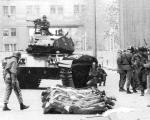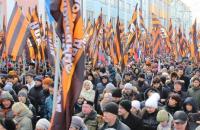On September 2, 1945, the Japanese Empire surrendered unconditionally. The hotbed of war in the Asia-Pacific region was extinguished. The second World War ended. Russia-USSR, despite all the intrigues of obvious enemies and "partners", confidently entered the phase of restoration of the Empire. Thanks to the wise and decisive policy of Joseph Stalin and his associates, Russia has successfully restored its military-strategic and economic positions in the European (western) and Far Eastern strategic directions.
At the same time, it should be canceled that Japan, like Germany, was not the real instigator of the world war. They played the role of figures in the Great Game, where the prize is the entire planet. The real instigators of the world massacre were not punished. Although it was the masters of the United States and Great Britain who unleashed the world war. The Anglo-Saxons nurtured Hitler and the Eternal Reich project. The dreams of the "possessed Fuhrer" about the New World Order and the domination of the "chosen" caste over the rest of the "subhumans" were just a repetition of English racial theory and social Darwinism. Britain has long been building the New World Order, where there was a metropolis and colonies, dominions, it was the Anglo-Saxons who created the world's first concentration camps, not the Germans.
London and Washington sponsored the revival of Germany's military power and gave it almost all of Europe, including France. For Hitler to lead the "crusade to the East" and crush the Russian (Soviet) civilization, which carried the beginnings of a different, just world order, challenging the shadow masters of the Western world.
The Anglo-Saxons pitted the Russians and the Germans against each other for the second time in order to destroy the two great powers, whose strategic alliance could permanently establish peace and prosperity in Europe and much of the world. At the same time, an elite battle took place within the Western world itself. The Anglo-Saxon elite dealt a powerful blow to the old German-Roman elite, seizing the leading positions in Western civilization. The consequences for Europe were dire. The Anglo-Saxons still control Europe, sacrificing its interests. The European nations are condemned, they must assimilate, become part of the "global Babylon".
However, not all of the global plans of the owners of the western project were realized. The Soviet Union not only was not destroyed and withstood the hardest battle with the united forces of Europe, but also became a superpower that thwarted the plans to establish the "Eternal Reich" (New World Order). For several decades Soviet civilization became for mankind a beacon of Good and Justice, a model of a different path of development. The Stalinist society of service and creation was an example of a society of the future that can save humanity from the dead end of a consumer society that leads people to degradation and planetary catastrophe.
The Chief of the General Staff, General Umezu Yoshijiro, signs the Japan Surrender Act. Behind him is Japanese Foreign Minister Shigemitsu Mamoru, who has already signed the Act.

General Douglas MacArthur signs Japan's surrender

Lieutenant General Konstantin N. Derevyanko, on behalf of the USSR, signs the Act of Japan's surrender aboard the American battleship Missouri Japan surrender
The crushing offensive of the Soviet Army, which led to the defeat and surrender of the Kwantung Army (;;), dramatically changed the military-political situation in Far East... All plans of the Japanese military-political leadership to drag out the war collapsed. The Japanese government feared an invasion of the Japanese islands by Soviet troops and a radical change in the political system.
The blow of Soviet troops from the northern direction and the threat of a successive invasion of Soviet troops through the narrow straits to the Kuriles and Hokkaido was considered more significant than the landing of the Americans on the Japanese islands proper after their passage by sea from Okinawa, Guam and the Philippines. The American landing party hoped to drown thousands of suicide bombers in blood, and, in the worst case scenario, retreat to Manchuria. The blow of the Soviet Army deprived the Japanese elite of this hope. Moreover, the Soviet troops with a rapid offensive deprived Japan of their bacteriological reserves. Japan has lost the ability to retaliate against the enemy, to use weapons of mass destruction.
At a meeting of the Supreme Military Council on August 9, 1945, the head of the Japanese government, Suzuki, said: "The entry of the Soviet Union into the war this morning puts us finally in a desperate situation and makes it impossible to continue the war further." At this meeting, the conditions under which Japan agreed to accept the Potsdam Declaration were discussed. The Japanese elite was practically unanimous in the opinion that it was necessary to preserve the imperial power at any cost. Suzuki and other "peace advocates" believed that in order to preserve the imperial power and prevent revolution, it was necessary to surrender immediately. Representatives of the military party continued to insist on the continuation of the war.
On August 10, 1945, the Supreme War Council adopted the text of a statement to the Allied Powers proposed by Prime Minister Suzuki and Foreign Minister Shigenori Togo. The text of the statement was supported by Emperor Hirohito: “The Japanese Government is ready to accept the terms of the Declaration of July 26 this year, to which the Soviet Government also joined. The Japanese Government understands that this Declaration does not contain requirements that infringe upon the prerogatives of the emperor as the sovereign ruler of Japan. The Japanese government asks for specific notification in this regard. " On August 11, the governments of the USSR, USA, Great Britain and China sent a response. It stated that the power of the emperor and the government of Japan from the moment of surrender would be subordinate to the supreme commander of the allied powers; the emperor must ensure that Japan signs the terms of surrender; the form of government in Japan will ultimately be established by the freely expressed will of the people in accordance with the Potsdam Declaration; the armed forces of the allied powers will remain in Japan until the goals set out in the Potsdam Declaration are achieved.
Meanwhile, disputes continued among the Japanese elite. And in Manchuria there were fierce battles. The military insisted on continuing the struggle. On August 10, an appeal by the Minister of the Army Koretica Anami to the troops was published, in which it was emphasized that it was necessary "to bring the holy war to the end." The same appeal was issued on August 11. On August 12, Tokyo radio broadcast a message that the army and navy, "carrying out the imperial order commanding the defense of the homeland and the emperor's most important person, have everywhere switched to active hostilities against the allies."
However, no orders could change reality: the Kwantung Army was defeated, and it became pointless to continue resistance. Under pressure from the emperor and the "party of peace", the military were forced to reconcile. On August 14, at a joint meeting of the Supreme Military Council and the government in the presence of the emperor, it was decided to unconditionally surrender Japan. In the decree of the emperor on Japan's acceptance of the terms of the Potsdam Declaration, the main place was given to the preservation of the "national political system."
On the night of August 15, supporters of the continuation of the war revolted and occupied the imperial palace. They did not encroach on the life of the emperor, but wanted to change the government. However, by the morning of August 15, the mutiny was suppressed. On August 15, the population of Japan for the first time in their country heard the emperor's speech on the radio (on record) about unconditional surrender. On this day and later, many military men committed a samurai suicide - seppuku. So, on August 15, the Minister of the Army, Koretika Anami, committed suicide.
This is a characteristic feature of Japan - a high level of discipline and responsibility among the elite, which continued the traditions of the military class (samurai). Believing themselves to be guilty for the defeat and misfortune of their homeland, many Japanese chose to commit suicide.
The USSR and the Western powers disagreed in assessing the Japanese government's statement of surrender. The USA and Great Britain considered that August 14-15 were the last days of the war. August 14, 1945 became the "Day of Victory over Japan." By this point, Japan had indeed ceased hostilities against the US-British military. However, hostilities were still continuing on the territory of Manchuria, Central China, Korea, Sakhalin and the Kuril Islands. There the Japanese in a number of places resisted until the end of August, and only the offensive of the Soviet troops forced them to lay down their arms.
When it became known about the readiness of the Japanese Empire to capitulate, the question arose of appointing the supreme commander of the allied powers in the Far East. Its functions were to include the acceptance of the general surrender of the Japanese armed forces. The American government on August 12 proposed General D. MacArthur for this post. Moscow agreed with this proposal and appointed Lieutenant General K. N. Derevyanko as the USSR representative under the Supreme Commander of the Allied armies.
On August 15, the Americans announced the draft "General Order No. 1", which indicated the areas of acceptance of the surrender of the Japanese troops by each of the allied powers. The order stipulated that the Japanese in Northeast China, in the northern part of Korea (north of the 38th parallel) and in southern Sakhalin would surrender to the Commander-in-Chief of Soviet troops in the Far East. The surrender of Japanese troops in the southern part of Korea (south of the 38th parallel) was to be accepted by the Americans. The American command refused to conduct a landing operation in South Korea in order to interact with Soviet troops. The Americans preferred to land troops in Korea only after the end of the war, when the risk was no longer there.
Moscow as a whole did not object to the general content of General Order No. 1, but made several amendments. The Soviet government proposed to include in the area where Japanese forces were surrendered to Soviet troops all the Kuril Islands, which, by agreement in Yalta, were transferred to the Soviet Union and the northern part of the island of Hokkaido. The Americans did not raise serious objections to the Kuril Islands, since the issue of them was resolved at the Yalta Conference. However, the Americans still tried to nullify the decision of the Crimean Conference. On August 18, 1945, the day the Kuril operation began, Moscow received a message from US President Truman, which spoke of the US desire to obtain the rights to create an air base on one of the Kuril Islands, presumably in the central part, for military and commercial purposes. Moscow firmly rejected these claims.
As for the question of Hokkaido, Washington rejected the Soviet proposal and insisted that Japanese troops on all four islands of Japan proper (Hokkaido, Honshu, Shikoku, and Kyushu) surrender to the Americans. At the same time, the United States did not formally deny the USSR the right to temporarily occupy Japan. "General MacArthur," the American president said, "will use the symbolic allied armed forces, which, of course, will include the Soviet armed forces, to temporarily occupy as much of Japan proper as he deems necessary to occupy in order to implement our allied terms of surrender." But in fact, the United States has relied on unilateral control in Japan. Truman spoke at a conference in Washington on August 16 and said that Japan, like Germany, would not be divided into occupation zones, that the entire Japanese territory would be under American control.
In fact, the United States gave up allied control in post-war Japan, provided for in the Potsdam Declaration of July 26, 1945. Washington was not going to let Japan out of its sphere of influence. Before World War II Japan was under the great influence of Britain and the United States, now the Americans wanted to restore their positions. The interests of American capital were also taken into account.
After August 14, the USA repeatedly tried to put pressure on the USSR in order to stop the offensive of Soviet troops against the Japanese. The Americans wanted to limit the zone of Soviet influence. If Russian troops did not occupy South Sakhalin, the Kuriles and North Korea, then American forces could appear there. On August 15, MacArthur handed over to the Soviet Headquarters a directive to end offensive operations in the Far East, although the Soviet troops did not obey the allied command. Then the allies were forced to admit the "mistake." They say that the directive was passed not for "execution", but for "information". It is clear that this position of the United States did not contribute to the strengthening of friendship between the allies. It became clear that the world was heading for a new clash - now between the former allies. The United States tried with rather tough pressure to stop the further spread of the zone of Soviet influence.
This US policy played into the hands of the Japanese elite. The Japanese, like the Germans before, hoped to the last that a major conflict would occur between the allies, right up to an armed clash. Although the Japanese, like the Germans before, miscalculated. At this point, the United States was betting on Kuomintang China. The Anglo-Saxons first used Japan, provoking it to the outbreak of hostilities in the Pacific Ocean zone, to aggression against China and the USSR. True, the Japanese dodged and, having received tough military lessons, did not attack the USSR. But on the whole, the Japanese elite lost, being drawn into the war with the United States and Britain. The weight classes were too different. The Anglo-Saxons used Japan, and in 1945 it was time to bring it under full control, right up to the military occupation that continues to this day. Japan became at first an almost open colony of the United States, and then a semi-colony, a dependent satellite.
All the preparatory work for organizing the official Act of Surrender was carried out at MacArthur's headquarters in Manila. On August 19, 1945, representatives of the Japanese headquarters arrived here, headed by the Deputy Chief of the General Staff of the Imperial Japanese Army, Lieutenant General Torashiro Kawabe. It is characteristic that the Japanese sent their delegation to the Philippines only when they were finally convinced that the Kwantung Army had been defeated.
On the day the Japanese delegation arrived at MacArthur's headquarters there, a "denunciation" of the Japanese government on the Soviet troops, which had begun an operation on the Kuril Islands, was received from Tokyo by radio. The Russians were accused of violating the alleged "prohibition of hostilities" that existed after August 14. It was a provocation. The Japanese wanted the allied command to intervene in the actions of the Soviet troops. On August 20, MacArthur declared: "I sincerely hope that, pending the formal signing of surrender, a truce will prevail on all fronts and that surrender can be carried out without the shedding of blood." That is, it was a hint that Moscow was to blame for the “shedding of blood”. However, the Soviet command was not going to stop hostilities before the Japanese cease resistance and lay down their arms in Manchuria, Korea, South Sakhalin and the Kuril Islands.
The Act of Surrender, agreed upon by the allied countries, was handed over to the Japanese representatives in Manila. General MacArthur notified the Japanese headquarters on August 26 that the American fleet was moving towards Tokyo Bay. The American armada consisted of about 400 ships, and 1300 aircraft, which were based on aircraft carriers. On 28 August, forward American forces landed at Atsugi airfield, near Tokyo. On August 30, a mass landing of American troops began in the area of the Japanese capital and in other regions of the country. On the same day, MacArthur arrived and took control of the Tokyo radio station and created an information bureau.
For the first time in the history of Japan, its territory was occupied by foreign troops. She had never had to surrender before. On September 2, 1945, the signing ceremony of the Act of Surrender took place in Tokyo Bay aboard the American battleship Missouri. On behalf of the Japanese government, the Act was signed by Foreign Minister Mamoru Shigemitsu, on behalf of the Imperial Headquarters, General Staff Chief General Yoshijiro Umezu signed it. On behalf of all the allied nations, the Act was signed by the Supreme Commander of the Allied Armies, General of the US Army Douglas MacArthur, from the USA - Admiral of the Fleet Chester Nimitz, from the USSR - Lieutenant General Kuzma Derevyanko, from China - General Xu Yongchan, from Britain - Admiral Bruce Fraser. Representatives of Australia, New Zealand, Canada, Holland and France also put their signatures.
According to the Act of Surrender, Japan accepted the terms of the Potsdam Declaration and declared the unconditional surrender of all armed forces, both its own and those under its control. All Japanese troops and population were ordered to immediately cease hostilities, to keep ships, aircraft, military and civilian property; the Japanese government and the General Staff were instructed to immediately release all Allied prisoners of war and civilian internees; the power of the emperor and government was subordinate to the supreme allied command, which must take measures to implement the terms of surrender.

Japan finally ended its resistance. The occupation of the Japanese islands by American troops began with the participation of British forces (mainly Australians). By September 2, 1945, the surrender of the Japanese troops, which opposed the Soviet Army, was completed. At the same time, the remnants of Japanese forces in the Philippines surrendered. The disarmament and capture of other Japanese groups dragged on. On September 5, the British landed in Singapore. On September 12, the Act of Surrender of the Japanese Armed Forces in Southeast Asia was signed in Singapore. On September 14, the same ceremony was held in Malaya, on September 15 - in New Guinea and North Borneo. On September 16, British troops entered Xianggang (Hong Kong).
The surrender of the Japanese troops in Central and North China proceeded with great difficulties. The offensive of Soviet troops in Manchuria created favorable opportunities for the liberation of the rest of China from the invaders. However, Chiang Kai-shek's regime stuck to its line. The Kuomintang now considered the main adversary not to the Japanese, but to the Chinese communists. Chiang Kai-shek made a deal with the Japanese, giving them "the duty of maintaining order." Meanwhile, the people's liberation troops were successfully advancing in the regions of North, Central and South China. Within two months, from August 11 to October 10, 1945, the 8th and New 4th People's Armies destroyed, wounded and captured more than 230 thousand soldiers of the Japanese and puppet troops. The people's troops liberated large territories and dozens of cities.
However, Chiang Kai-shek continued to bend his line and tried to prohibit accepting the enemy's surrender. The transfer of Kuomintang troops on American planes and ships to Shanghai, Nanjing and Tanjing was organized under the pretext of disarming Japanese troops, although these cities had already been blocked by popular forces. The Kuomintang was deployed in order to increase the pressure on the people's armies of China. At the same time, Japanese troops took part in hostilities on the side of the Kuomintang for several months. The signing of the surrender on October 9 in Nanjing by Japanese troops was formal. The Japanese were not disarmed and until 1946 they fought as mercenaries against the popular forces. The Japanese soldiers were formed into detachments of volunteers to fight the communists and used to guard railways... And three months after Japan's surrender, tens of thousands of Japanese soldiers did not lay down their arms and fought on the side of the Kuomintang. The Japanese commander-in-chief in China, General Teiji Okamura, was still in his headquarters in Nanjing and was now subordinate to the Kuomintang government.
Modern Japan should remember the lesson of September 2, 1945. The Japanese should be aware that the Anglo-Saxons played them off in 1904-1905. with Russia, and then for decades set Japan against Russia (USSR) and China. That it was the United States that bombarded the Yamato race and turned Japan into its semi-colony. That only friendship and a strategic alliance along the Moscow-Tokyo line can provide a period of long prosperity and security in the Asia-Pacific region. The Japanese people do not need to repeat old mistakes in the 21st century. The enmity between the Russians and the Japanese only plays into the hands of the owners of the Western project. There are no fundamental contradictions between the Russian and Japanese civilizations, and they are doomed to creation by history itself. In the future, the Moscow-Tokyo-Beijing axis could ensure peace and prosperity in most of the Eastern Hemisphere for centuries. The union of three great civilizations will help keep the world from chaos and catastrophe, to which the masters of the West are pushing humanity.
Ctrl Enter
Spotted Osh S bku Highlight text and press Ctrl + Enter
The article was written by political scientist and Japanese scholar Vasily Molodyakov
On September 2, 1945, aboard the American battleship Missouri in Tokyo Bay, representatives of the victorious Allied Powers and the defeated Land of the Rising Sun signed the Japan Unconditional Surrender Act. World War II is over - on Pacific and everywhere.
Peace has come, but questions remain. Why did the Japanese, who fought with selfless and sometimes insane courage, disciplined themselves to lay down their arms? Why did Tokyo first reject the Potsdam Declaration of the Allies and decide to continue the senseless resistance, and then agree to its terms? And, perhaps, the main thing: what played a decisive role in the decision to surrender - the American atomic bombings of Hiroshima and Nagasaki or the entry of the USSR into the war with Japan?
The question is not only historical, but also political. If the former, then the Americans saved one hundred million Japanese at the cost of several hundred thousand lives, and the Soviet Union behaved like a "thief in a fire," to put it mildly, taking advantage of the predicament of a neighbor. If the latter, then our country had every right, at least, to its share of the spoils of war and to participate in the management of defeated Japan. American and Japanese propaganda under its control adhered to the first point of view, Soviet propaganda - the second.
American historian of Russian descent George Lensen wittily remarked: “Naturally, the history of the war in the Pacific Ocean for the American reader will include a photograph of General MacArthur when he signs the Japan Surrender Act on the deck of the Missouri, while a similar story for the Soviet the reader will be shown the same scene, but with Lieutenant General Kuzma Derevyanko signing the Act, while MacArthur and everyone else will stand in the background. "
To answer this question, we will have to go back a little over a month from the events described - to the Potsdam conference of the “Big Three”. On July 26, the Potsdam Declaration of the USA, Great Britain and China (Chiang Kai-shek signed "by telegraph") demanded the unconditional surrender of Japan. “Below are our terms. We will not deviate from them. There is no choice. We will not tolerate any delay ... Otherwise, Japan will face a quick and complete defeat. " Charged in advance by the Americans, the declaration in one of the versions provided for Stalin's signature. President Harry Truman announced that he was going to Potsdam in order to ensure the participation of the USSR in the war with Japan, but as the atomic project approached a successful conclusion, he felt more and more doubts about the need to share the winner's laurels with “Uncle Joe”.
The Potsdam Declaration, in the form in which it was adopted and published, left almost no hope that Japan would accept it: it did not say a word about the fate of the emperor and the political system, which was the main concern of those in power in Tokyo. Consequently, it untied the hands of the United States to use nuclear weapons. At the same time, she presented the Soviet Union with the fact that such an important decision was made without his participation and without the ability to influence him.
Secretary of State James Byrnes's explanation that Truman did not want to embarrass the USSR as a country not at war with Japan angered Stalin. Back on May 28, 1945, while discussing Far Eastern affairs in Moscow with the White House special envoy Harry Hopkins, he said that he prefers a compromise peace with Japan on the condition of complete destruction of its military potential and the occupation of the country, but softer than in Germany, explaining, that demanding unconditional surrender would force the Japanese to fight to the last. Stalin announced that the Soviet Union would be ready to enter the war no earlier than August 8 (the army command insisted on a later date to complete the preparations), and raised the issue of participation in the occupation of Japan. Hopkins offered to present Tokyo with an ultimatum on behalf of the United States and the USSR. The Secretary General agreed and advised to include this issue on the agenda of the conference. He even brought with him to Potsdam a draft statement of the four powers, but his text, which sounded softer than the American one, remained unclaimed.
On July 28, at the beginning of a regular meeting, Stalin told Truman and British Prime Minister Clement Attlee that "we, the Russian delegation, have received a new proposal from Japan." "Although we are not properly informed when a document is being drawn up about Japan," he pointedly remarked, "however, we believe that we should inform each other about new proposals." Then, as stated in the minutes, was read English translation"Japan's mediation notes." What is this document?
On July 13, the Japanese ambassador to Moscow, Naotake Sato, handed the text of the message of the Japanese emperor to Deputy People's Commissar for Foreign Affairs Solomon Lozovsky, explaining that for its official presentation, former Prime Minister Fumimaro Konoe would like to arrive in Moscow as a special envoy and confidant of the monarch. Here is a translation of this document from the Russian Foreign Policy Archive:
“His Majesty the Emperor of Japan, deeply concerned about the calamities and casualties of the peoples of all the belligerent countries, which are increasing day by day as a result of the current war, expresses his will to end the war as soon as possible. Since in the East Asian War, the United States and England insist on unconditional surrender, the Empire will be forced to bring the war to the end, mobilizing all forces and means, for the honor and existence of the Fatherland. However, as a result of this circumstance, inevitably increased bloodshed among the peoples of both belligerents. His Majesty is extremely disturbed in this thought and expresses the wish that peace be restored for the good of mankind as soon as possible. "
Lozovsky noticed that the message had no addressee and it was not clear to whom it was sent. The ambassador, according to the minutes of the conversation, replied that it “is not specifically addressed to anyone. It is desirable that the head of state, Mr. Kalinin, and the head of the Soviet government, Stalin, familiarize themselves with it. " The leadership of the "land of the gods" - as always - wanted to first find out whether Konoe would be accepted in the Kremlin, and only then open the cards. In Tokyo, the Supreme Council for War Leadership continued to discuss what could be offered to the Soviet Union for helping out of the war. In Konoe's "suitcase" lay South Sakhalin, the Kuriles, Manchuria as a sphere of influence, the rejection of fishing rights, and even the surrender of the Kwantung Army, which the Japanese, for obvious reasons, do not like to remember.
Stalin did not intend to receive the envoy from Tokyo "in advance". On July 18, Lozovsky replied to the ambassador: “The considerations expressed in the message of the Emperor of Japan have a general form and do not contain any specific proposals. The Soviet Government also finds it unclear what the mission of Prince Konoe is. In view of the above, the Soviet Government does not see an opportunity to give any definite answer regarding the mission of Prince Konoe. " Upon receiving this polite refusal, Sato immediately sent a telegram to Foreign Minister Shigenori Togo, in which he offered to immediately agree to surrender. Togo resolutely replied that Japan would resist to the last, and ordered to obtain Moscow's consent to the arrival of the Konoe mission. Fulfilling the order of the chief, the ambassador on July 25 again tried to persuade Lozovsky. But it was too late.
"There is nothing new in this document," Stalin remarked, informing Truman and Attlee of the emperor's message. - There is only one proposal: Japan offers us cooperation. We think to answer them in the same spirit as it was last time, ”that is, with a polite refusal.
Having learned about the Potsdam Declaration from a BBC radio broadcast, Ambassador Sato concluded that such a document could not have appeared without prior notification and the consent of the Soviet side. He immediately informed the Foreign Ministry that this was the answer to the proposal to send Konoe's mission. Confusion reigned in Tokyo. The army did not allow the declaration to be adopted, but Togo persuaded him not to officially reject it, so as not to aggravate the situation. The newspapers got the word mokusatsu - "kill by silence" or "ignore" - which began to determine the position of the government.
On August 5, Stalin and Molotov returned to Moscow. On August 6, the first American atomic bomb was dropped on Hiroshima. Truman could not hide his joy and notified the whole world of what had happened. Japan's Minister of War, General Koretika Anami, turned to physicists with the question of what the "atomic bomb" is. The Soviet leader did not ask such questions. Back in Potsdam, he learned that the United States has nuclear weapons, but did not expect such a quick use. Stalin realized that this was a warning not only to the Japanese, and decided not to hesitate.
On August 8, at 5 pm Moscow time, Molotov received the Japanese ambassador, who had long asked to see him. There was no need to talk about Konoe's mission. The People's Commissar immediately interrupted the guest, saying that he had to make an important statement: from midnight on August 9, i.e. just an hour later, Tokyo time, the USSR and Japan are at war. The reasoning is simple: Tokyo rejected the demands of the Potsdam Declaration; the allies turned to the USSR with a request to enter the war, and the latter, "true to the allied duty," accepted the offer.
The assertion that the allies asked Moscow to join the war follows from the minutes of the Potsdam conference, published by the USSR Ministry of Foreign Affairs. However, in the published minutes of the conversation between Molotov and Truman on July 29, a note was made, which was restored by historians only in 1995: “Molotov says that he has proposals related to the situation in the Far East. It would be a convenient excuse for the Soviet Union to enter the war against Japan if the allies asked him about it (emphasis mine - V.M.). One could indicate that, in connection with Japan's rejection of the demand for surrender ... "and so on, as later in the Soviet statement.
When did the Soviet leadership decide to go to war with Japan? The political decision about this was first announced by Stalin - in deep secrecy - in October 1943 at the Moscow conference of foreign ministers of the anti-Hitler coalition, and was included in the minutes at the Tehran conference of the Big Three in late November - early December of the same year. The Japanese, of course, did not know about this. They consoled themselves with the absence of Chiang Kai-shek in the Iranian capital, which made it possible to consider the conference a military council against Germany. The absence of Soviet representatives at the Cairo conference, when Roosevelt and Churchill met with Chiang Kai-shek on their way to Tehran, was interpreted in a similar way. It was there that the declaration was adopted demanding the unconditional surrender of Japan, published on December 1, 1943.
When did Moscow make the tactical decision to enter the war in the Far East? It is difficult to say for sure, but at the Yalta Conference in February 1945 it was officially confirmed. Under a secret agreement dated February 11, the Soviet Union received South Sakhalin and the Kuriles for this; Dairen became an international port with preemptive rights of the USSR; Port Arthur was returned to the Soviet Union as a rented naval base; The CER and YMZhD passed under Soviet-Chinese control, ensuring the priority interests of the USSR and the full sovereignty of China in Manchuria; the state of Manchukuo was liquidated and became part of China, which, in turn, renounced any rights and claims to Outer Mongolia (MPR). On July 26 and 27, a joint meeting of the Politburo and Headquarters finally consolidated the decision on the USSR's entry into the war, which the next day was brought to the notice of the executors by three directives signed by Stalin.
Immediately after midnight on August 9, the Soviet army attacked Japanese positions in Manchuria and Korea. A few hours later, a second American bomb was dropped on Nagasaki. In the evening of the same day, the Imperial Conference was held in a palace bomb shelter in Tokyo - a meeting of the monarch, the chairman of the Privy Council, the prime minister, key ministers and chiefs of general staff of the army and navy. There was only one question: to accept or not to accept the Potsdam Declaration. Realizing that the war was lost, the emperor resisted unconditional surrender, counting to the last on the mediation of Moscow. Now there was nothing to hope for, which was directly stated by Prime Minister Kantaro Suzuki. The resolution, prepared by the Foreign Ministry, provided for the adoption of the terms of the declaration, "understanding them in the sense that they do not contain a requirement to change the status of the Japanese emperor established by state laws." Under pressure from the Minister of War and the Chiefs of Staff, the Supreme Council for the Leadership of the War agreed to surrender under the following conditions: “1) it does not affect the imperial family; 2) Japanese troops outside the country are demobilized after their free withdrawal from the occupied territories; 3) war criminals will be subject to the jurisdiction of the Japanese government; 4) the occupation will not be carried out in order to guarantee (the fulfillment of the terms of surrender - VM) ”. The foreign minister suggested limiting ourselves to the first point. The military insisted on all four. The emperor approved the Foreign Ministry's project, but Washington rejected it, not wanting to hear about any reservations.
Only on August 14, the cabinet was able to work out the text of the rescript of the surrender. The emperor decided to address the people on the radio with an appeal to "endure the unbearable." On the night of August 14-15, a group of officers of the capital's garrison tried to revolt, seize the original recording of the august appeal made the day before, in order to prevent it from being broadcast, and destroy the "capitulators" from the government. The performance failed due to lack of support, and its ringleaders committed suicide. On August 15, the Japanese heard the voice of the divine monarch for the first time in history. It is this date that is considered in the Land of the Rising Sun as the day of the end of the war.
American historian Tsuyoshi Hasegawa, Japanese by birth, wrote the best, to date, comprehensive study of this issue "Race with the enemy. Stalin, Truman and Japan's surrender, "published in 2005. His verdict, based on the first combined Japanese, Soviet and American sources, reads:" The entry of the USSR into the war shocked the Japanese more than atomic bombs, because it put an end to all hopes come to an agreement even slightly different from unconditional surrender ... (It) played a greater role than atomic bombs in forcing Japan to surrender. "
Of course, in this matter, scientists still have something to do. But if you approach the problem comprehensively and impartially, the verdict is unlikely to be different.
ACT OF CAPITULATION OF JAPAN, See Art. The surrender of Japan ... Great Patriotic War 1941-1945: an encyclopedia
JAPAN CAPITULATION ACT 1945- 2.9, a joint document of the allied powers on Japan's unconditional surrender, presented. its representatives. Signed on board Amer. battleship "Missouri" by representatives of Japan, USA, USSR, Great Britain, Australia, Canada, China, France, ... ... Encyclopedia of Strategic Missile Forces
- ... Wikipedia
Japan's Unconditional Surrender Act- signed on September 2, 1945, depriving Japan, which was defeated in the Second World War, of all the lands it had ever seized: South Sakhalin, the Kuril Islands, Manchuria, Korea, Taiwan, etc. Glossary of terms (glossary) on the history of the state and law of foreign countries
The style of this article is not encyclopedic or violates the norms of the Russian language. The article should be corrected according to the stylistic rules of Wikipedia ... Wikipedia
September 2, 1945, the event that ended the hostilities in World War II. By the end of July 1945, the Imperial Japanese Navy had lost its combat readiness, and there was a threat of an Allied invasion of Japan. While ... ... Wikipedia
- 連 合 国 軍 占領 下 の 日本 Military occupation ← ... Wikipedia
It was signed on September 2, 1945. Having made a preliminary decision and having received the emperor's approval for negotiations on an armistice, the Japanese government, overcoming internal difficulties, tried to contact the governments of the USSR, the USA and England in order to ... ... All of Japan
General Governorate of Korea 朝鮮 General Governorship ← ... Wikipedia
Japan's surrender in World War II- Planning entry into World War II, the ruling circles of Japan hoped that Great Britain and France, engaged in the war in Europe, would not be able to allocate sufficient forces to defend their colonies and strongholds in Asia, and the USSR's main efforts ... ... Encyclopedia of Newsmakers
Books
- When Sakura Blooms ..., Alexey Voronkov. On September 2, 1945, the act of unconditional surrender of Japan was signed aboard the American missile cruiser Missouri. The Second World War ended, the armies returned to their places ...
- When cherry blossoms bloom, Voronkov A.A. On September 2, 1945, an act of unconditional surrender of Japan was signed on board the American missile cruiser Missouri. The Second World War ended, the armies returned to their places ...
To the question "What caused Japan's surrender?" there are two popular answers. Option A - the atomic bombings of Hiroshima and Nagasaki. Option B - Red Army's Manchurian operation.
Then the discussion begins: what turned out to be more important - the dropped atomic bombs or the defeat of the Kwantung Army.
Both proposed options are incorrect: neither the atomic bombings nor the defeat of the Kwantung Army were decisive - these were only the final chords of the Second World War.
A more balanced answer assumes that the fate of Japan was determined by four years of hostilities in the Pacific Ocean. Oddly enough, but this answer is also a "double bottom" truth. Behind the landing operations on tropical islands, the actions of aircraft and submarines, hot artillery duels and torpedo attacks by surface ships, there is a simple and obvious conclusion:
The war in the Pacific was planned by the United States, initiated by the United States, and fought in the interests of the United States.
The fate of Japan was predetermined in the early spring of 1941 - as soon as the Japanese leadership succumbed to American provocations and began to seriously discuss plans to prepare for the coming war. To a war in which Japan had no chance of winning.
The Roosevelt administration calculated everything in advance.
The inhabitants of the White House knew very well that the industrial potential and resource base of the United States was many times greater than the indicators of the Japanese Empire, and in the field of scientific and technological progress, the United States was at least a decade ahead of its future adversary. The war with Japan will bring enormous benefits to the United States - if successful (the probability of which was considered to be 100%), the United States will crush its only rival in the Asia-Pacific region and become absolute hegemon in the vastness of the Pacific Ocean. The risk of the enterprise was reduced to zero - the continental part of the United States was completely invulnerable to the Imperial army and navy.

The main thing is to make the Japs play by American rules and get involved in a losing game. America shouldn't start first - it should be a "war of the people, a holy war", in which the good Yankees crush the evil and vile enemy who risked attacking America.
Fortunately for the Yankees, the Tokyo government and the General Staff turned out to be too arrogant and arrogant: the intoxication of easy victories in China and Indochina caused an unjustified feeling of euphoria and the illusion of their own strength.
Japan successfully spoiled relations with the United States - back in December 1937, the planes of the Imperial Air Force sank the American gunboat Panai on the Yangtze River. Confident in its own power, Japan did not seek compromises and defiantly went to the conflict. The war was inevitable.
The Americans accelerated the process, teased the enemy with deliberately impossible diplomatic notes and stifled economic sanctions, forcing Japan to make the only decision that seemed acceptable to it - to go to war with the United States.
Roosevelt did his best and achieved his goal.
"How we should maneuver them into the position of firing the first shot without allowing too much danger to ourselves"
"... how can we get Japan to fire the first shot without putting ourselves in significant danger"
- entry in the diary of US Secretary of War Henry Stimson of 11/25/1941, dedicated to the conversation with Roosevelt about the expected Japanese attackYes, it all started with Pearl Harbor.
Whether it was a "ritual sacrifice" of American foreign policy, or the Yankees became victims of their own sloppiness - we can only speculate. At least, the events of the next 6 months of the war clearly indicate that Pearl Harbor could have happened without any intervention of "dark forces" - the American army and navy at the beginning of the war demonstrated their complete incapacity.
Nevertheless, the "Great Defeat at Pearl Harbor" is an artificially inflated myth with the aim of provoking a wave of popular anger and creating the image of a "formidable enemy" for rallying the American nation. In fact, the losses were minimal.
Japanese pilots managed to sink 5 ancient battleships (out of 17 available at that time in the US Navy), three of which were returned to service in the period from 1942 to 1944.
In total, as a result of the raid, 18 of the 90 US Navy ships anchored in Pearl Harbor that day received various damage. Irrecoverable losses among the personnel amounted to 2402 people - less than the number of victims of the terrorist attack on September 11, 2001. The base infrastructure remained intact. - Everything is according to the American plan.

It is often said that the main failure of the Japanese is related to the absence of American aircraft carriers in the base. Alas, even if the Japanese managed to burn the Enterprise and Lexington, together with the entire Pearl Harbor naval base, the outcome of the war would remain the same.
As time has shown, America could DAILY launch two or three warships of the main classes (aircraft carriers, cruisers, destroyers and submarines - minesweepers, hunters and torpedo boats do not count).
Roosevelt knew about it. The Japanese are not. Desperate attempts by Admiral Yamamoto to convince the Japanese leadership that the existing American fleet is just the visible tip of the iceberg and an attempt to solve the problem by military means would lead to disaster, did not lead to anything.

The capabilities of the American industry made it possible to instantly compensate for ANY losses, and the growing, by leaps and bounds, the US Armed Forces literally "crushed" the Japanese Empire like a powerful steam roller.
The turning point in the war in the Pacific came already in late 1942 - early 1943: after gaining a foothold in the Solomon Islands, the Americans accumulated enough strength and began to destroy the Japanese defensive perimeter with all their fury.

Dying Japanese cruiser "Mikuma"
Everything happened as the American leadership had hoped. Subsequent events represent a pure "beating of babies" - in the conditions of absolute domination of the enemy at sea and in the air, the ships of the Japanese fleet perished en masse, not even having time to approach the American one.
After many days of storming Japanese positions using naval artillery, not a single whole tree remained on many tropical islands - the Yankees literally washed the enemy into powder.
Post-war research will show that the ratio of casualties of the personnel of the Armed Forces of the United States and Japan is described by a ratio of 1: 9! By August 1945, Japan will lose 1.9 million of its sons, the most experienced fighters and commanders will die, Admiral Isoroku Yamamoto - the most sane of the Japanese commanders - will be out of the game (killed as a result of a special operation by the US Air Force in 1943, a rare case in, when the killers are sent to the commander).
In the fall of 1944, the Yankees kicked the Japanese out of the Philippines, leaving Japan with practically no oil, along the way, the last combat-ready formations of the Imperial Navy were defeated - from that moment even the most desperate optimists from the Japanese General Staff lost faith in any favorable outcome of the war. Ahead loomed the prospect of an American landing on the sacred Japanese land, with the subsequent destruction of the Land of the Rising Sun as an independent state.

Landing in Okinawa
By the spring of 1945, only the burnt ruins of cruisers who managed to escape death on the high seas and were now slowly dying of wounds in the harbor of the Kure naval base remained of the once formidable Imperial Navy. The Americans and their allies almost completely exterminated the Japanese merchant fleet, putting island Japan on "starvation rations." Due to the lack of raw materials and fuel, Japanese industry practically ceased to exist. Big cities metropolitan areas of Tokyo turned into ashes one after another - massive raids of B-29 bombers became a nightmare for the inhabitants of the cities of Tokyo, Osaka, Nagoya, Kobe. On the night of March 9-10, 1945, the most devastating conventional raid in history took place: three hundred Super Fortresses dropped 1,700 tons of incendiary bombs on Tokyo. Over 40 square meters were destroyed and burned. kilometers of the city, over 100,000 people died in the fire. The factories have stopped, from
Tokyo experienced a massive exodus of the population.
“Japanese cities, being made of wood and paper, will catch fire very easily. The army can engage in self-glorification as much as it wants, but if a war breaks out and there are large-scale air raids, it's scary to imagine what will happen then. "
- prophecy of Admiral Yamamoto, 1939In the summer of 1945, carrier aviation raids and massive shelling of the coast of Japan by battleships and cruisers of the US Navy began - the Yankees finished off the last pockets of resistance, destroyed airfields, once again "shook up" the Kure naval base, finally finishing off what the sailors did not manage to finish off during battles on the high seas ...
This is how Japan of August 1945 appears before us.
Kwantung pogrom
There is an opinion that the crooked Yankees fought with Japan for 4 years, and the Red Army defeated the "Japs" in two weeks.
In this, at first glance, absurd statement, both truth and fiction are uncomplicatedly intertwined.
Indeed, the Manchurian operation of the Red Army is a masterpiece of military art: a classic blitzkrieg on an area equal in area to two Zap. Europe!


Breakthroughs of motorized columns through the mountains, daring landings on enemy airfields and monstrous cauldrons in which our grandfathers "boiled" the Kwantung Army alive in less than 1.5 weeks.
The Yuzhno-Sakhalin and Kuril operations went just as well. It took our paratroopers five days to capture Shumshi Island - for comparison, the Yankees stormed Iwo Jima for more than a month!
However, there is a logical explanation for each of the miracles. One simple fact speaks of what the "formidable" 850,000-strong Kwantung Army was in the summer of 1945: Japanese aviation, for a combination of many reasons (lack of fuel and experienced pilots, outdated materiel, etc.), did not even try to rise into the air - the offensive of the Red Army was carried out with the absolute supremacy of Soviet aviation in the air.
In the units and formations of the Kwantung Army, there were absolutely no machine guns, anti-tank guns, rocket artillery, there was little RGK and large-caliber artillery (in infantry divisions and brigades as part of artillery regiments and divisions, in most cases there were 75-mm guns).
- "History of the Great Patriotic War"(Vol. 5, p. 548-549)Not surprisingly, the 1945 Red Army simply did not notice the presence of such a strange enemy. Irrecoverable losses in the operation amounted to "only" 12 thousand people. (of which half was carried away by illness and accidents). For comparison: during the storming of Berlin, the Red Army lost up to 15 thousand people. in one day.
A similar situation developed in the Kuriles and South Sakhalin - by that time the Japanese did not even have destroyers left, the offensive came with complete domination of the sea and in the air, and the fortifications on the islands of the Kuril ridge were not very similar to what the Yankees faced on Tarawa and Iwo Jima.
The Soviet offensive finally put Japan to a standstill - even the illusory hope for the continuation of the war disappeared. Further chronology of events is as follows:
August 9, 1945, 00:00 Trans-Baikal time - the Soviet military machine was activated, the Manchurian operation began.
August 10 - Japan officially announced its readiness to accept the Potsdam terms of surrender with a reservation regarding the preservation of the structure of imperial power in the country.
September 2 - The Japanese Surrender Act is signed aboard the battleship USS Missuori in Tokyo Bay.
It is obvious that the first nuclear bombing of Hiroshima (August 6) failed to change the Japanese leadership's decision to continue senseless resistance. The Japanese simply did not have time to realize the destructive power of the atomic bomb, as for the severe destruction and losses among the civilian population - the example of the March bombing of Tokyo proves that no less casualties and destruction did not affect the determination of the Japanese leadership to "stand to the last." The bombing of Hiroshima can be viewed as a military action aimed at destroying a strategically important enemy target, or as an act of intimidation towards the Soviet Union. But not as a key factor in Japan's surrender.
As for the ethical moment of the use of nuclear weapons, the bitterness during the Second World War reached such proportions that anyone who had such a weapon - Hitler, Churchill or Stalin, without batting an eye, would give an order to use it. Alas, at that time only the United States had nuclear bombs - America incinerated two Japanese cities, and now, for 70 years, it has been justifying its actions.
The most difficult question lies in the events of August 9-14, 1945 - what became the "cornerstone" in the war, which finally forced Japan to change its mind and accept the humiliating terms of surrender? Repetition of the nuclear nightmare or the loss of the last hope associated with the possibility of concluding a separate peace with the USSR?
I am afraid that we will never know the exact answer about what was happening in the minds of the Japanese leadership in those days.

Tokyo on fire

The fog slowly dissipates over Tokyo Bay on this historic day. Gradually, the silhouettes of the numerous ships of the allies loom, formidably lined up in front of the capital of Japan. The destroyer rushes us to the battleship, on which the signing ceremony of Japan's surrender is to take place.
This destroyer is a small but dashing ship. With a torpedo attack, he sank the cruiser "James", two enemy submarines, shot down 9 Japanese aircraft in his lifetime. Now he is taking representatives of the press of all freedom-loving nations to his flagship. Before us is one of the largest warships in the world - the Missouri. To the right and to the left of him are his comrades-in-arms - the American battleships Iowa, South Dakota, behind them - the best English battleships Georg, Duke of York. Further on the roads are Australian, Dutch, Canadian, New Zealand cruisers, destroyers. Ships of all classes are innumerable. The battleship "Missouri", on which the signing of the act will take place, is not without reason given such an honor. At the head of the squadron, on March 24, he approached the shores of Japan and fired at the area north of Tokyo with his gigantic guns. Behind this battleship there are many other combat cases. He deserves the hatred of his enemies. On April 11, she was attacked by a Japanese suicide pilot and, having crashed, inflicted only minor damage on the ship.
The destroyer Budkonan, on which General MacArthur arrived, was moored to the starboard side of the battleship. Following them, the delegation of the allied countries and guests climb aboard the battleship. The delegation takes their places at the back of the table. From right to left - representatives of China, Great Britain, USSR, Australia, Canada, France, Holland, New Zealand. Guests, over 230 correspondents, are accommodated in the bow of the battleship, filling the captain's bridge, all the gun platforms of the tower. Preparations for the ceremony are coming to an end. A small table is covered with a green cloth, two inkpots and blotting paper are placed. Then two chairs appear, one opposite the other. A microphone is installed. Everything is done slowly.
The Japanese delegation, consisting of eleven people, who were brought by boat after the preparation of the entire ceremony, is going up the ladder. With the general silence of those present, representatives of the arrogant Japanese diplomacy and rabid military clique approach the table. Ahead, all in black, the head of the Japanese delegation, Japanese Foreign Minister Mamoru Shigemitsu. Behind him is the plump, squat Chief of the Army General Staff of Japan, General Umezu. With them are Japanese diplomatic and military officials in motley uniforms and suits. This whole group is miserable! For five minutes, the Japanese delegation stands under the stern gaze of all representatives of the freedom-loving nations present on the ship. The Japanese have to stand just opposite the Chinese delegation.
Representative of the USSR, Lieutenant General K.N. Derevianko signs the Japan Surrender Act. US Navy battleship Missouri, Tokyo Bay, September 2, 1945 Photo: N. Petrov. RGAKFD. Arch.N 0-253498
General MacArthur appears on the deck of the ship. In general silence, MacArthur addresses the delegation and guests. Having finished his speech, MacArthur with a coarse gesture invites the Japanese delegates to come to the table. Shigemitsu walks up slowly. After awkwardly fulfilling his heavy duty, Shigemitsu walks away from the table without looking at anyone. General Umezu diligently puts his signature. The Japanese retire to their places. MacArthur approaches the folders laid out on the table and invites two American generals - Waynwright and Percival - the heroes of Corregidor with him. Only recently have they been wrested from Japanese captivity - a few days ago, Wainwright was liberated by the Red Army in Manchuria. After MacArthur, the Chinese delegates sign the act. For the Chinese, the English Admiral Fraser approaches the table.
The crackling and clicking of numerous cameras and movie cameras increase when MacArthur invites the Soviet delegation to the table. She's in the spotlight here. Those present see in her the representatives of the powerful Soviet state, which, having defeated Nazi Germany, then hastened the surrender of Japan. Lieutenant General Derevyanko, who signs the act on the authorization of the Supreme Commander-in-Chief of the Soviet Armed Forces, is accompanied by Aviation Major General Voronov and Rear Admiral Stetsenko. General Derevianko is followed by Australian General Blamy, Canadian representative General Grave, French delegate General Leclerc, representatives of Holland and New Zealand.
The act has been signed. Convinced that a lasting peace has now been established throughout the world, MacArthur finishes the procedure with a smile and asks the signatory delegations to follow them to the salon of Admiral Nimitz on the Missouri. The Japanese delegates stand alone for a while. Shigemitsu is then handed a black folder with a copy of the signed deed. The Japanese go down the ladder, where the boat is waiting for them. Over the battleship Missouri, the Flying Fortresses float in a majestic parade; Following this, in the implementation of the act of surrender, hundreds of landing ships with troops rush to Tokyo and Yokohama to occupy the Japanese islands.
MISSOURI (BB-63) is an American Iowa-class battleship. Launched on January 29, 1944 (NewYork NavalShipyard). Its keel was laid on January 6, 1941. About 10 thousand people took part in the construction of the powerful ship. Length 271 m. Width 33 m. Draft 10 m. Displacement 57 thousand tons. Travel speed 33 knots. The cruising range is 15 thousand miles. The crew is 2800 people. The battleship's armor reached 15 cm thick. Each of its three gun turrets contained three sixteen-inch guns. There was no analogue to this weapon on the ships of the US Navy. Missouri shells pierced ten-meter concrete fortifications. The battleship had the most powerful air defense system in the world.



























